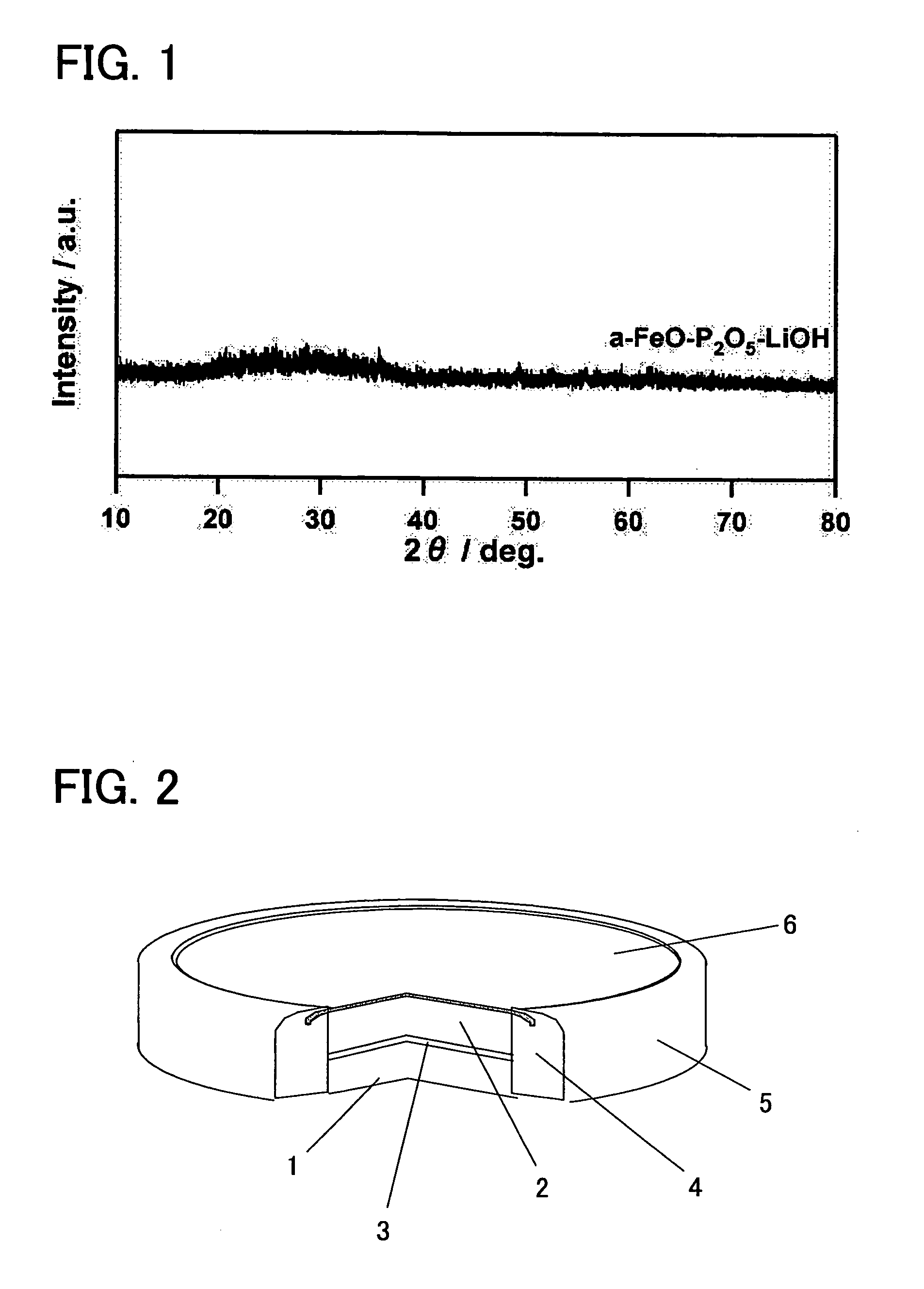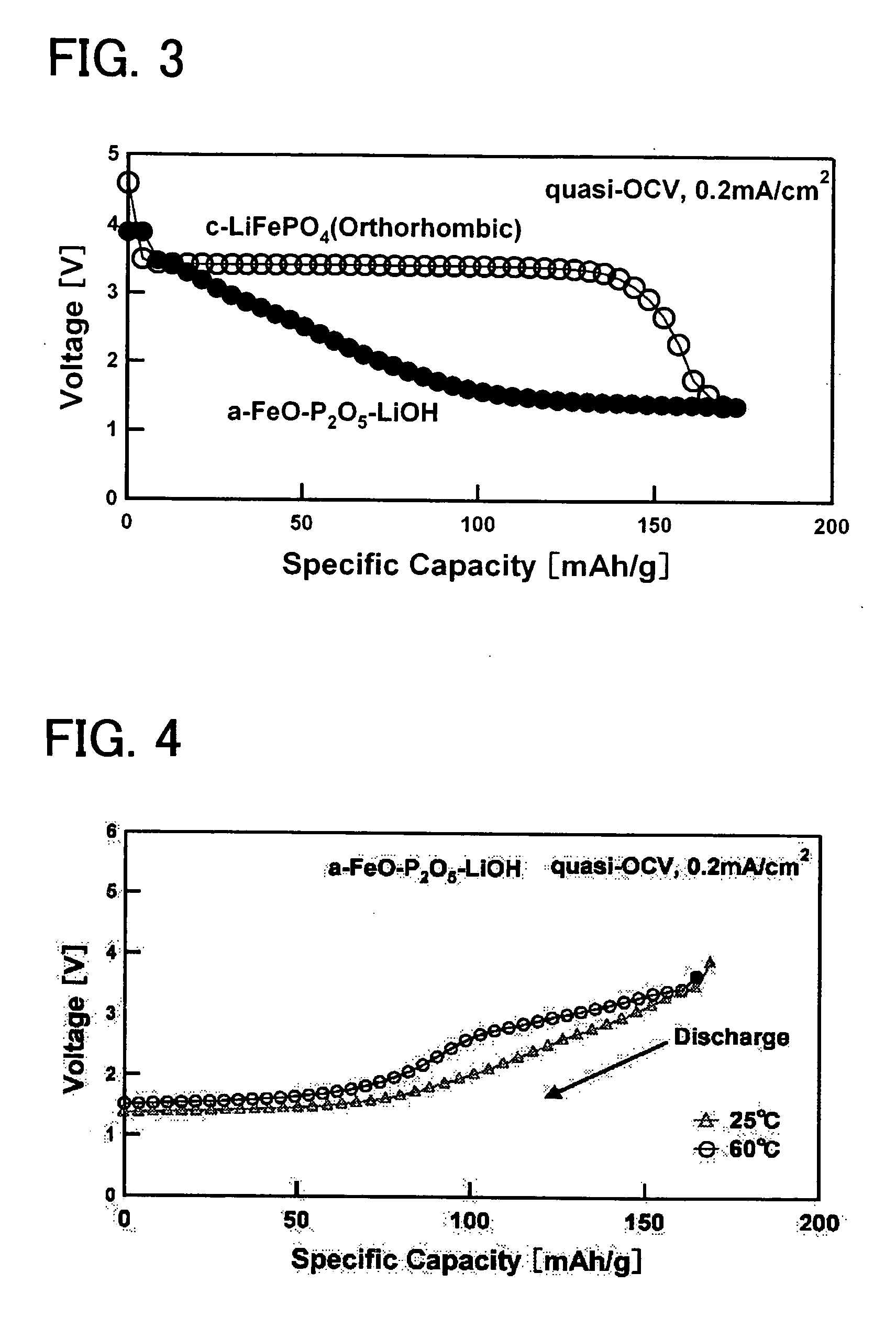Electroactive material and use thereof
a technology of electroactive materials and materials, applied in the field of electroactive materials, can solve the problems that iron oxides that are inexpensive and have low reactivity cannot be used as starting materials, and achieve the effect of improving charge/discharge characteristics and good battery characteristics
- Summary
- Abstract
- Description
- Claims
- Application Information
AI Technical Summary
Benefits of technology
Problems solved by technology
Method used
Image
Examples
experimental example 1
Production of an Amorphous Sample of a Bivalent Iron Olivine Composition by Means of the Simple Roll Method and Confirmation of the Amorphization Thereof
[0041] In order to attain an amorphous material having a bivalent iron olivine composition, a bivalent iron oxide was employed as a starting material (Fe source) to produce an amorphous sample. More specifically, FeO, P2O5, and LiOH.H2O were mixed together at a molar ratio of 1:0.5:1. This mixture was melted for 5 minutes at 1500° C. in the presence of an Ar atmosphere in order to maintain the Fe in a bivalent state, and a single roll quenching device was employed to rapidly cool the same with a 2000 rpm single roll. The resulting product was milled by a standard method to obtain a sample (average particle diameter of approximately 16.8 μm), and powder X-ray diffraction (XRD) measurements were performed. An X-ray diffraction device (model number “Rigaku RINT 2100HLR / PC”) which can be obtained from Rigaku Corporation was employed fo...
experimental example 2
Production of an Amorphous Sample of a Bivalent Fe Olivine Composition by Means of the Melt Quench Method and Confirmation of the Amorphization Thereof
[0042] In order to attain an amorphous material having a bivalent iron olivine composition, a bivalent iron oxide was employed as a starting material (Fe source) to produce an amorphous sample. More specifically, FeO, P2O5, and LiOH.H2O were mixed together at a molar ratio of 1:0.5:1. This mixture was melted for 5 minutes in an atmosphere oven in the presence of an Ar atmosphere in order to maintain the Fe in the bivalent state, and was then promptly removed and quench pressed. The resulting product was milled by a standard method to obtain a sample (average particle diameter of approximately 16.8 μm), and powder X-ray diffraction (XRD) measurements were performed. An X-ray diffraction device (model number “Rigaku RINT 2100HLR / PC”) which can be obtained from Rigaku Corporation was employed for the measurements. Although not shown in ...
experimental example 3
Production of an Amorphous Sample of a Trivalent Fe Nasicon Composition by Means of the Simple Roll Method or Melt Quench Method and Confirmation of the Amorphization Thereof
[0043] In order to attain an amorphous material having a trivalent iron Nasicon composition, a tiivalent iron oxide was employed as a starting material (Fe source) to produce an amorphous sample. More specifically, Fe2O3, P2O5, and LiOH.H2O were mixed together at a molar ratio of 1:1.5:3. This mixture was melted for 5 minutes at 1500° C. in the presence of atmospheric air, and a single roll quenching device was employed to rapidly cool the same with a 2000 rpm single roll. Alternatively, the mixture was melted for 5 minutes in an electric oven in the presence of atmospheric air, and then quench pressed. Each of the resulting products obtained by these rapid cooling methods were milled by a standard method to obtain a sample (average particle diameter of approximately 16.8 μm), and powder X-ray diffraction (XRD)...
PUM
| Property | Measurement | Unit |
|---|---|---|
| temperature | aaaaa | aaaaa |
| particle diameter | aaaaa | aaaaa |
| thickness | aaaaa | aaaaa |
Abstract
Description
Claims
Application Information
 Login to View More
Login to View More - R&D
- Intellectual Property
- Life Sciences
- Materials
- Tech Scout
- Unparalleled Data Quality
- Higher Quality Content
- 60% Fewer Hallucinations
Browse by: Latest US Patents, China's latest patents, Technical Efficacy Thesaurus, Application Domain, Technology Topic, Popular Technical Reports.
© 2025 PatSnap. All rights reserved.Legal|Privacy policy|Modern Slavery Act Transparency Statement|Sitemap|About US| Contact US: help@patsnap.com



